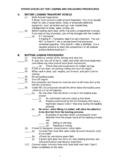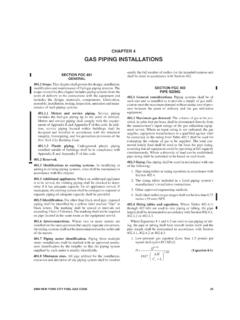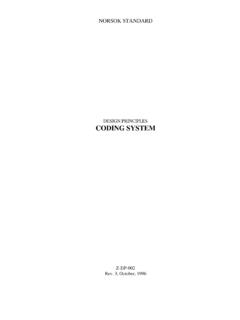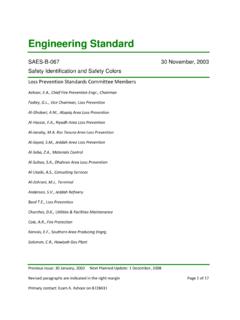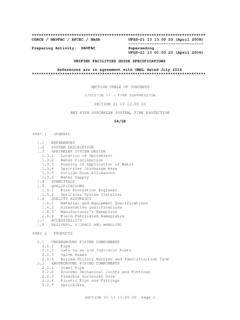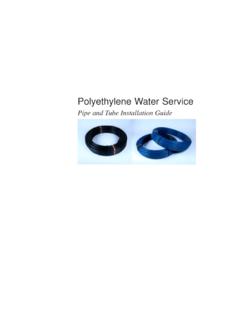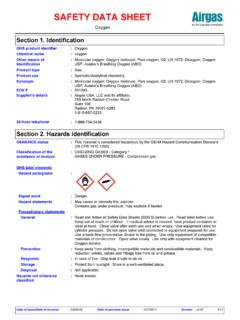Transcription of DRIVER CHECKLIST FOR LOADING AND …
1 DRIVER CHECKLIST FOR LOADING AND unloading procedures . A. before LOADING transport VEHICLE. _____ (1) Walk Around Inspections: A DRIVER must conduct a walk around inspection. You must visually check for any unusual odors, noise, or physically defective equipment, such as broken springs, over heated tires, misalignment of axles, leaks, smoke, etc. _____ (2) before LOADING each load, verify that every compartment is empty. If you load on top of product, you will be charged with the incident. _____ (a) K-1 Kerosene: If LOADING K-1 Kerosene, step 2 is very important. You are NOT to load K-1 into a compartment that previously contained gasoline. Only load K-1 after a distillate. It is a required practice to drain the compartment of all residual product before LOADING K-1. B. BOTTOM LOADING procedures . _____ (1) Stop delivery vehicle at the LOADING rack stop line. _____ (2) At stop line, turn off all lights, radio, and other electrical equipment (and follow any other posted local plant procedures ).
2 _____ (a) Check tires and suspension for broken springs. _____ (3) If rack is not clear, set parking brakes and shut off engine. _____ (4) When rack is clear, start engine, pull forward, and spot truck for LOADING . _____ (5) Re-set parking brake. _____ (6) Shut off engine. _____ (7) Eye protection and bump hat must be worn at all times during the transfer of product. _____ (8) Under NO circumstances should the DRIVER leave the LOADING area unless due to an emergency. _____ (a) No one other than the DRIVER is to be in the LOADING area except: _____ (i) An authorized instructor training that DRIVER . _____ (ii) Persons authorized by the Oil Company who have a legitimate reason to be in that area during the LOADING process. _____ (b) No DRIVER , while filling his trailer, will allow his attention to be diverted from the LOADING process. _____(i) Examples of activities which unnecessarily divert attention from the proper focus of the LOADING process are: _____ (a) Eating or drinking _____ (b) Reading or writing _____ (9) If trailer is equipped, check product retain lights.
3 _____ (a) Connect high level fiber optic cable (ground line/scully cord). to the trailer _____ (b) +Check for permissive green light _____ (c) If green light does not come on, stop LOADING process, see instructions/plant attendant/or supervisor. _____ (10) Connect vapor recovery hose and close both cam-lock ( ears ). levers completely on the hose. 1. _____ (11) Open fitting box and open internal valves as required. _____ (12) Connect the appropriate leading arms When connecting a LOADING arm coupler to the trailer pipe, slide the collar on the adapter before actuating the lever, which locks the collar and opens the valve. Do not force the collar on with the lever cam. This damages the lever arm and shear pin. _____ (13) Open internal valves as required. _____ (14) Clear registers and set pre-sets for the proper gallons for each compartment. Know the capacities of all compartments on the trailer. The pre-set counter must never be set to an amount greater that the legal/safe fill capacity of the compartment being filled.
4 _____ (15) Start the appropriate product pumps. _____ (16) At each meter: _____ (a) Verify product, pre-set gallon amount and LOADING arm connection to the correct compartment. _____ (b) Actuate start mechanism. _____ (c) Verify that the pre-set meter countdown is working properly. _____ (d) Verify there are no leaks. _____ (17) Observe slow-flow shutdown of all meters. If slow-flow does not engage at 50-30 gallons, stop flow immediately by pressing stop button on pre-set. Do not bypass slow-flow. Report to management. _____ (18) After each compartment is loaded, close the internal valve for that compartment. When a compartment is filled beyond safe-fill capacity, the LOADING rack high level control monitor will not permit further LOADING . If additional LOADING is necessary, the DRIVER must follow local procedures for draining product (which will include notifying plant management) so that the LOADING rack high-level control monitor returns to a permissive state.
5 On units equipped with an on-board overfill indicator, it may be necessary to press a reset button to get a green light on the rack monitor. _____ (19) After LOADING is completed, disconnect and stow LOADING arms. _____ (20) Make sure drop heads are hooked up and interlock bar is down and locked. _____ (21) Close fitting box doors and secure. _____ (22) Disconnect vapor recovery hose. Secure vapor hose to its holder on the rack and lock cam-lock ( ears ). _____ (23) Disconnect high level fiber optic cable and secure. Remember, this is the first thing connected and the last disconnected. _____ (24) Immediately look down the right side of the trailer to ensure that all LOADING equipment has been disconnected and stowed in its proper position. _____ (25) Move unit from the LOADING rack to designated parking area. _____ (a) Set parking brakes _____ (b) Shut off engine DO NOT LEAVE UNIT UNDER RACK AREA AFTER LOADING .
6 _____ (26) Report any spills or LOADING rack equipment malfunctions to plant management. _____ (27) Collect bill of lading/invoice and all other necessary documents. This procedure may vary for each LOADING terminal. 2. _____ (28) Ensure that the OSHA product identification labels and the emergency response guidebook are available in the truck cab _____ (29) NOTE: These procedures may change a little from one LOADING facility to another. You must become familiar with each LOADING facilities rules and regulations in order to do a good job. C. TROUBLESHOOTING HINTS. LOADING RACK PROBLEMS. _____ (1) NO GREEN LIGHT ON GROUND CIRCUIT/OVERFILL SENSOR. CONTROL. _____ (a) If green light is not illuminated . Bulb could be burned out Advise plant management _____ (b) If red light does not go off .. Plug contact points may be dirty. Spring-loaded contact in rack plug may be stuck in . Trailer wiring or sensor may be defective.
7 _____ (c) If light go to green and red each time connection is made . Sensor is reading possible retain; confirm compartment is empty. _____ (d) If light goes to red intermittently while LOADING . Rack-to-trailer connection is not making good contact. Compartment previously loaded is filled too close to sensor level and product is splashing against sensor. _____ (e) If light goes to steady red while LOADING . Compartment currently filling has reached high level sensor. Red light at trailer control box will show what compartment has scullyed out. Trailer-to-rack connection has lost contact. _____ (f) If light stays at a steady red and you can not get a green light, a sensor in one of the compartments may have gone bad. _____ (2) NO POWER TO TRAILER CONTROL BOX. _____ (a) If there is no power to trailer scully control box then the main fuse under the electrical pig-tail that hooks to the trailer may have blown.
8 Fuse is under pig-tail and glad hand hook ups _____ (b) At the main scully box on the side of the trailer you should have a green and yellow light on to let you know the scully system is operating. _____ (c) Losing ground connection between trailer and fifth wheel will not let scully turn green. _____ (3) CONDENSATION. _____ (a) In the winter months sometimes condensation will accumulate on sensors and keep the system from getting a green light. To correct this you will have to open the dome lid for that compartment and wipe. 3. D. API Color Symbols System for Proper ID of Fuel Storage Tanks, Fills & Piping The industry standard via the American Petroleum Institute for color codes. API Standard 1637- USING THE API COLOR-SYMBOL SYSTEM TO MARK EQUIPMENT AND VEHICLES FOR. PRODUCT IDENTIFICATION AT GASOLINE DISPENSING FACILITIES AND DISTRIBUTION. TERMINALS. (3rd Edition July 2006). NC Fire Code requires each fill pipe for motor fuel at a service station must have a label or must be painted a particular color to represent the product in the tank.
9 Furthermore, there must be a key or code chart for such color painting available inside the station office and every employee should be aware of the location of the color code at the station. NCDA-CS Handbook 44 also requires an ID system in place. If color code is used, a color chart is required at the place of business where it can be easily seen, preferably where it can be seen from the tanks. If a Standards Division Inspector (NCDA-CS) visits the station they must be able to determine what fill pipe represents what product and there must be a (color code) chart available to spell it out. Just using "memory" will not suffice. As to what colors are best for the various fuels sold - each company can use their own scheme but the recommendations of the American Petroleum Institute (API) are shown on this page. Anytime there is the slightest doubt as to color codes or what products that customer has stop and call dispatch.
10 SEE. CHART BELOW. ULS KEROSENE ULSD. U U. GASOLINES DISTILLATES & BIODIESEL UNDER 20% BLEND. UNLEADED LOW SULFUR HIGH SULFUR. High Grade Diesel Mid Grade No. 1 Fuel Oil Low Grade No. 2 Fuel Oil ALCOHOL BASED FUELS B2 Bio Heat (Not API). E85. Kerosene E15-E85 HIGH MID LOW. Above 10% Alcohol Blends Only (Bronze Color) B2 BIODIESEL B2, B5 or B20 (Bronze Color). USED OIL OBSERVATION WELL VAPOR RECOVERY. 4. E. before unloading transport VEHICLE. _____ (1) Verify products at location _____ (2) Verify color codes _____ (3) Call dispatch if any doubt _____ (4) Steps to take when you cannot identify color code _____ (a) Stick product and smell stick _____ (b) Stick product How it feels _____ (c) Stick product How it looks _____ (d) Products sold at pump island _____ (e) Look at drop holes for identification bands of products around filler neck or on ground around fill hole. _____ (f) Check with store manager for proper product drops _____ (g) Check with dispatch IF ALL THESE ITEMS ARE CHECKED AND YOU STILL.
